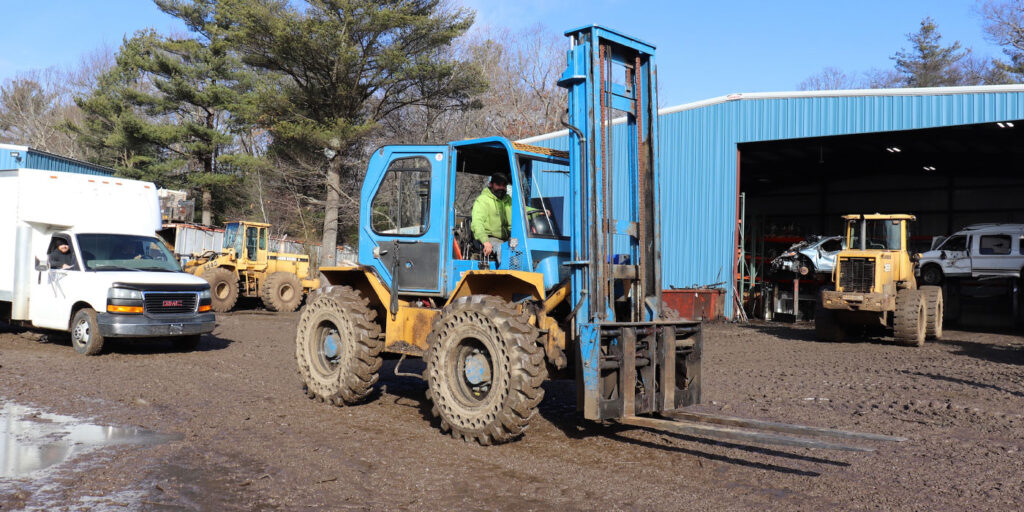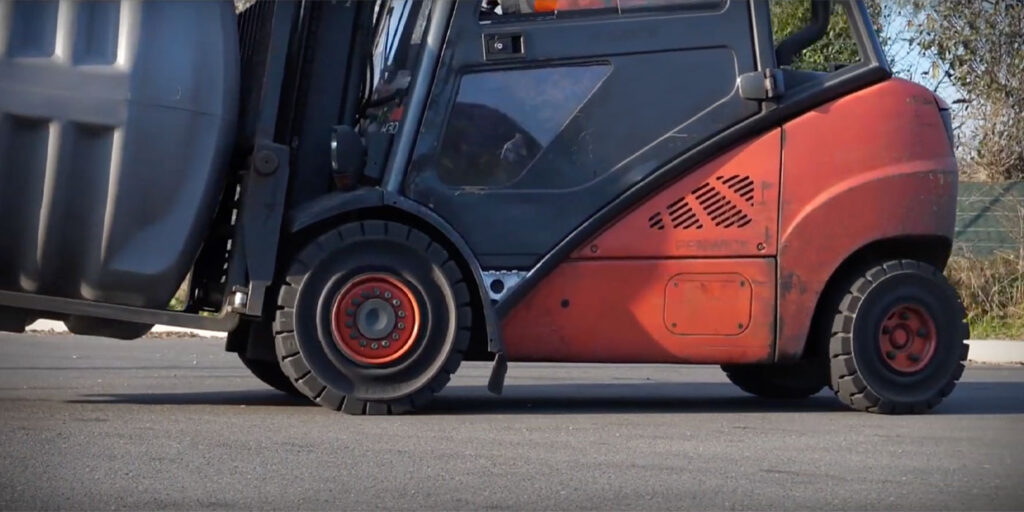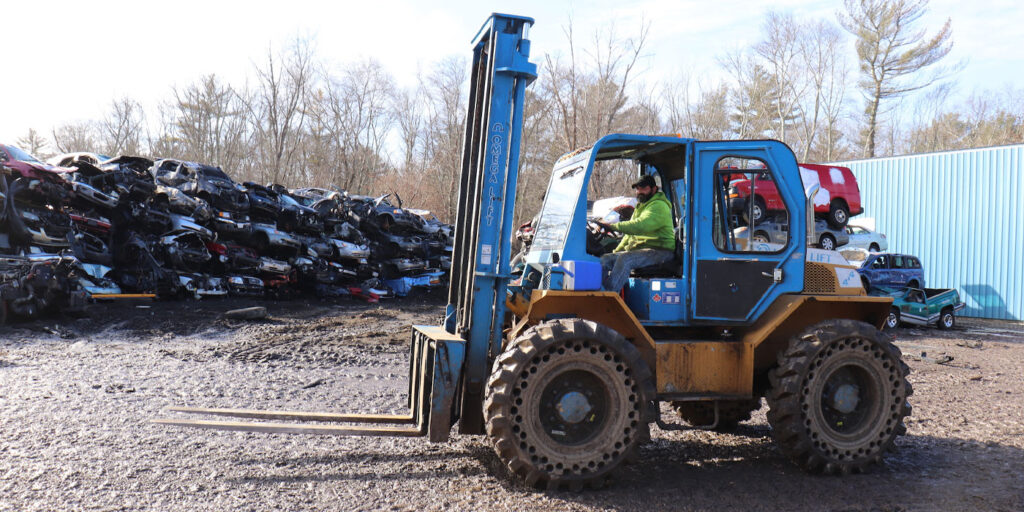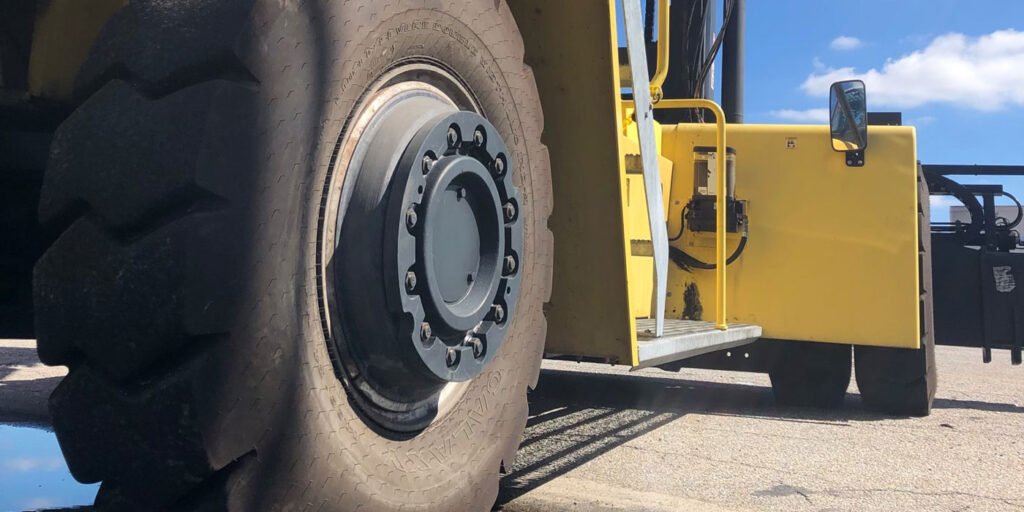The industrial market – dominated by forklifts, telehandlers and container handling equipment – is a complicated one. It’s full of special sizes, highly specific compounds and demanding applications. It’s very competitive, and many equipment operators drive as if they have made it their mission to destroy every tire they can.
Material handling machinery comes in a wide range of styles and sizes, from small electric forklifts that never see the light of day to straddle carriers and even larger rubber-tired gantries that move 20,000-lbs. shipping containers as if they were a child’s toys. There are a few common denominators, though. First, whether on nicely poured concrete warehouse floors, out in storage yards, or on the steaming pavement of a sunny port, industrial tires work brutally hard. The challenge is a combination of time and physics. Material handling is about speed, so operators are often turning on a dime, skidding, shifting from forward to reverse and back and running as fast as their equipment will allow. Many of those machines are in constant motion for two or three shifts a day, which accelerates wear and does not offer a cool-down period for the tires.
Material handling is also about lift, which is where the physics come into play. The tires supporting a lift’s forks are subject not only to the actual weight of the load, but if the lift has a telescoping boom, the weight can actually exert more force on the front tires as the boom extends away from the machine. This is true for a telehandler lifting a pallet to a second story or a container handler at a port stacking fully loaded cargo boxes five high.
Related equipment includes boom lifts and mobile elevated work platforms (MEWPs), which—like forklifts and telehandlers—require extremely stable tires, so reinforced sidewall construction and a flat, stable contact patch are significant elements in their design.
Tire Wear
Tire wear is a fact of life in the industrial tire market. The scrubbing action from sharp steering, turning while stopped and switching directions rapidly is a constant challenge in a warehouse or on the docks. Scrub-resistant compounds is absolutely vital in those applications. Stay on top of manufacturers’ innovations in compound development and field testing. Compound chemistry can have a significant impact on traction and wear resistance, as well as other important features such as non-marking properties. Longevity is also an important factor—for instance, tires used on straddle carriers and rubber-tired gantry cranes in ports must contain additives that resist cracking from UV light. Repeated trials of performance, service length and wear prove the value of those innovations in real-world conditions. Field tests can help you and your customer differentiate among competing options by predicting the cost per hour of a tire.

Smooth or Traction Tread?
For forklifts, smooth tires are often a logical choice to help extend service life and provide good traction. Where a traction tread is helpful—for instance, outdoors or in wet conditions—a non-directional tread pattern can help improve performance and reduce wear. As the name suggests, non-directional tread patterns are designed for excellent traction whether they are going forwards or backwards. Equally important, the tread pattern is also designed to wear well in both directions. Most also provide a comfortable ride for the operator, which can help improve productivity.
Like other off-highway tires, tread must be optimized for use and conditions. For instance, tires for rubber-tired gantries must be able to provide traction under great load, but also withstand enormous torque while being turned 90 degrees at a standstill. That requires not only an abrasion-resistant compound, but also a well-designed tread deep enough to wear well without being subject to its lugs being torn by the massive forces applied.

Minimizing Heat
In facilities such as warehouses, ports or intermodal facilities (where containers are moved among ships, trains and trucks), heat buildup is a significant risk due to constant movement, long workdays and hot conditions.
In fact, avoiding heat buildup in tires was such a challenge for operators of straddle carriers in container yards that it was the limiting factor in operating speed for many years. The problem was so significant that we at Yokohama Off-Highway Tires were asked to create a new port tire that could handle high loads at higher speeds than existing tires.
We developed a radial tire that combines heat-resistant compound with a new tread pattern that includes special heat-dissipating grooves between the main channels of the tread. Steel radial belts also help dissipate heat, and we built in a hexagonal bead to add stability and permit longer cycles. In all, the new tire permits cargo handlers to work long shifts at 21 mph.

Pneumatic, Foam, Solid
As in last month’s column about construction tires, your industrial tire customers can choose among pneumatic, foam-filled or solid tires based on their need for puncture resistance, wear, and acquisition cost. This is where your expertise as a tire dealer adds value to the relationship. You can help them walk through the decision, so they choose the best tire for their application.
Our back-of-the-envelope math in industrial applications has been that solid tires on concrete floors can cost roughly two to two-and-a-half times as much as their pneumatic counterpart, but typically deliver at least three times the service life. Factored across the life of the tire, that solid tire can deliver a significant return on investment where its extra durability is needed.
Choosing between solid and pneumatic, it is important to consider equipment speed, distance of travel and changes of direction. For instance, in a warehouse, speed is limited, and constant abrasion is a dominant factor, which could make solid tires a natural choice. At a port, both distance and speed are greater, more of the travel is in a straight path, and smooth ride can be a bigger issue, so pneumatics—and radial construction—can be a better choice for both performance and service life.
In all, the port segment is dominated by pneumatics, and we have seen about half of the forklift business is suited for solid tires, while the other half can benefit from the softer ride or the lower cost of pneumatic tires. As a sort of middle option, foam-filling pneumatic tires comes in close to solid tires for cost, weight and ride. In foam filling, the lower aspect ratios of some forklift and telehandler tires can offer an extra advantage by lowering the volume that must be filled.
My advice is to stay current on the latest innovations in this fast-moving, competitive market, then use your knowledge of tires and your understanding of your customers’ needs to help them connect with tires that perform for them. The constant need for new forklift, industrial and port tires can be the foundation of a long, productive relationship with your customers.
Ryan Lopes is national product manager—external communications for Yokohama Off-Highway Tires America, Inc. Combining his perspectives as a mechanical engineer and an MBA, Ryan’s passion has been working with the construction and industrial equipment sector around the world.














